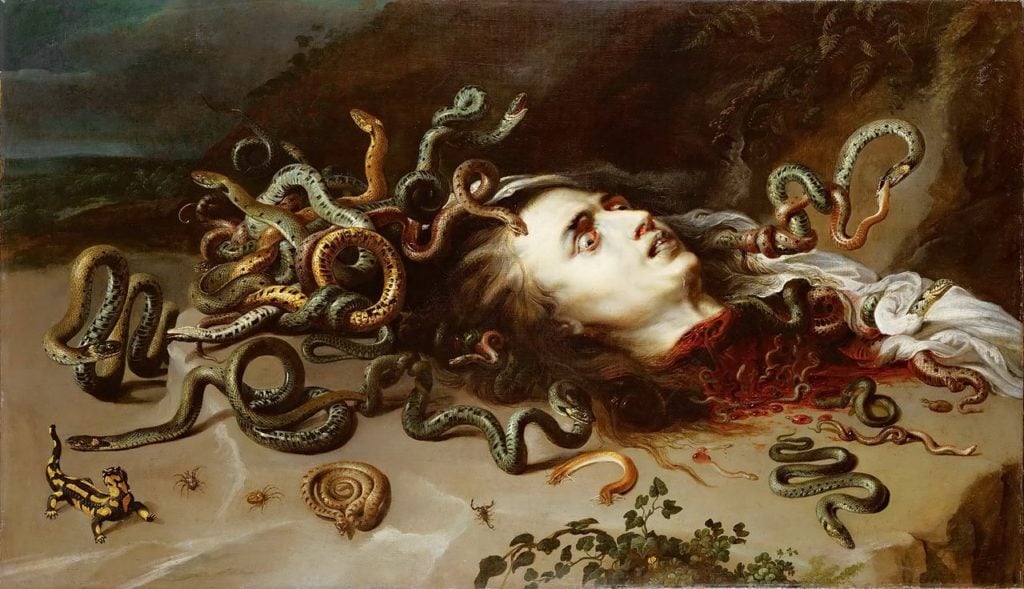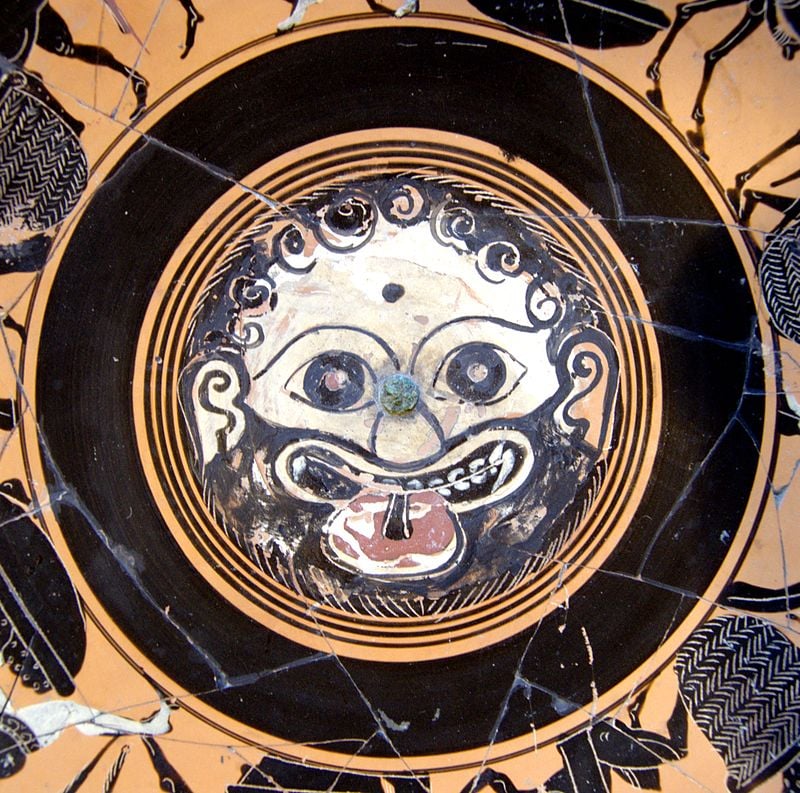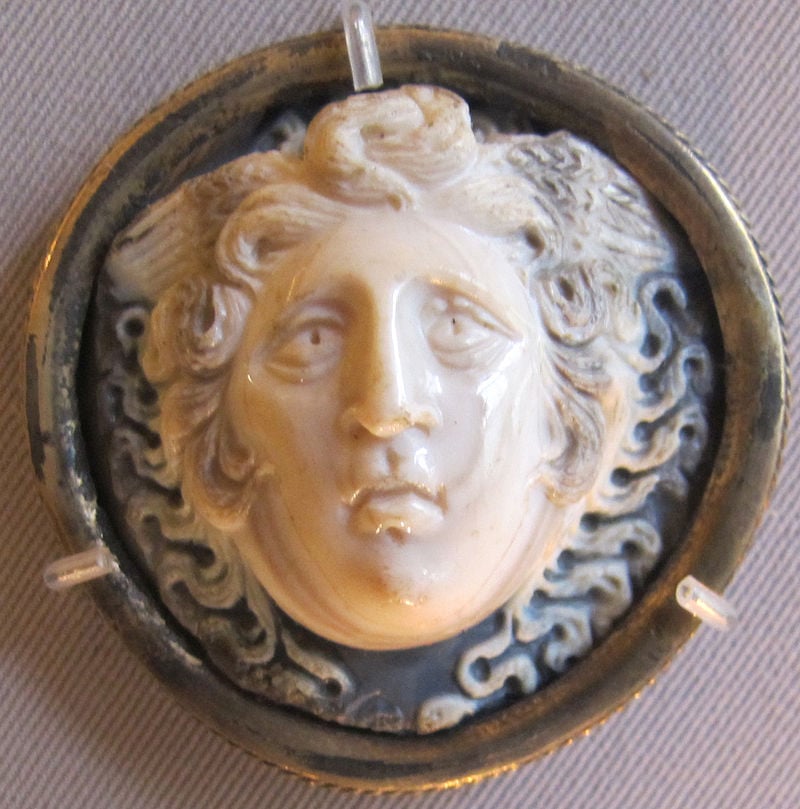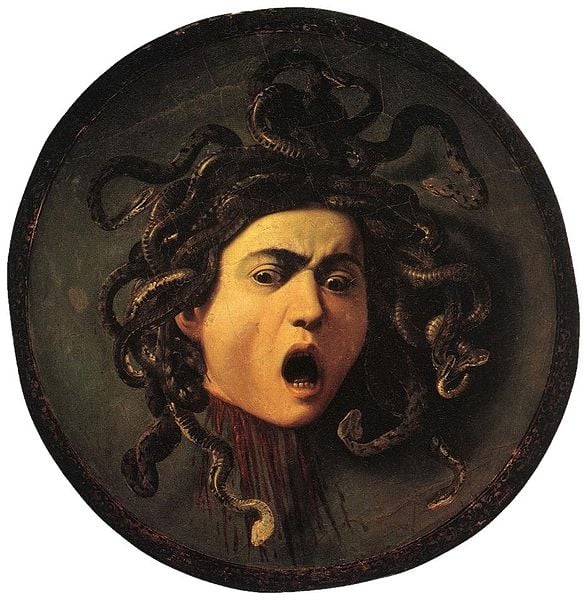
The representation of females in Greek mythology, including the Gorgon Medusa, has often included frightening images and ideas showing men’s fear of female power and their need to control or even destroy this power.
Like the monsters Scylla and Charybdis, as well as the Sphinx, Medusa, the “Gorgon,” was born from the gods herself.
Μέδουσα (as ‘Medusa’ is spelled in Greek), meaning “guardian, protectress,” who was also referred to as Gorgo, was one of the three monstrous Gorgons, generally described as winged human females with living venomous snakes in place of hair. Those who gazed into her eyes would turn to stone.
Most sources describe her as the daughter of Phorcys and Ceto although the author Hyginus refers to her as the daughter of Gorgon and Ceto.
Medusa was beheaded by the Greek hero Perseus, who thereafter used her head which retained its ability to turn onlookers to stone as a sort of weapon until he returned it to the goddess Athena to place on her shield. In classical antiquity, the image of the head of Medusa appeared in the supposedly evil-averting device known as the “Gorgoneion.”

In Ancient Greece, the Gorgoneion was a special apotropaic amulet portraying the Gorgon head used most famously by the Olympian deities Athena and Zeus both of whom are purported to have worn it as a talisman and are often depicted wearing it.
It established their descent from earlier deities who were thought to remain powerful. Among other attributes, it was assumed by the rulers of the Hellenistic age as a royal aegis that implied divine birth or protection. It was shown, for instance, on the Alexander Mosaic and the Gonzaga Cameo.

According to Hesiod and Aeschylus, Medusa lived and died on an island named Sarpedon, somewhere near Cisthene. The 2nd century BC novelist, Dionysios Skytobrachion, places her somewhere in Libya, where Herodotus had said the Berbers created her story and image as part of their religion.
Naturally, the Romans adopted the Medusa as part of their mythology, as well.
In Ovid’s work, Metamorphoses, from the first century AD, Medusa was portrayed as a terrifying Gorgon whose serpentine locks of hair turned anyone who met her gaze into stone.

Interestingly, much like the Sphinx, Scylla, and Charybdis of Greek mythology, Medusa ends up meeting her maker at the hands of a male hero. It does seem to beg the question of why all the female monsters in Greek mythology are killed by men.
Perseus somehow manages to do the Medusa in—but only with the help of magical tools including winged sandals from Hermes; an invisibility cap of invisibility from Hades, the god of the underworld, and a mirror-like shield that belonged to Athena, the goddess of wisdom and war.
Some believe all the Gorgons, the trio of winged females with venomous snakes for hair, descended from Gaia, the personification of Earth herself. Anyone who looked any of these powerful female figures straight in the face would turn to stone.

Perhaps reflecting the fear men had—and truthfully, often still have—of being sucked into a relationship because of the irresistible attractions of females, Medusa was portrayed as both deceptively beautiful and hideously ugly; of these three, however, Medusa was the only mortal Gorgon.
In the Roman poet Ovid’s version, Medusa had once been a beautiful maiden. However, after Poseidon, the sea god, raped her in the temple of Athena, the goddess sought revenge for the heinous act of defilement.
In an inexplicable act of cruelty, the goddess Athena herself, according to the male poet, of course, transformed Poseidon’s victim into a hideous monster.

Very interestingly, experts have noted that over time depictions of Medusa have changed drastically. Specifically, more and more female features were shown with the passing of time. Kiki Karaglou, curator of the Met exhibition “Dangerous Beauty: Medusa in Classical Art,” said in a 2018 interview that sculptures of the monster from the archaic Greek period from 700 to 480 B.C. are mostly androgynous figures.
Clearly designed to be ugly and threatening, they feature beards, tusks, and grimaces. In the Metropolitan Museum of Art show, Karaglou brought together more than 60 depictions of Medusa’s face throughout history.
Karaglou wrote in her 2018 essay that was published along with the exhibit that depictions of the Gorgon became notably more beautiful as time went along. “Beauty, like monstrosity, enthralls, and female beauty in particular was perceived—and, to a certain extent, is still perceived—to be both enchanting and dangerous, or even fatal,” she said.
This trope of the villainous, vampish female who posed a clear danger to men became more marked throughout the centuries, embodying the trope of an evil seductress which still endures to this day.
“Mens’ fear of women’s destructive potential”
In a recent story in Smithsonian magazine, author Nora McGreevy recalls remarks made by classicist Debbie Felton in an essay from 2013 which states that such tales, passed down through the generations, “spoke to men’s fear of women’s destructive potential. The myths then, to a certain extent, fulfill a male fantasy of conquering and controlling the female.”
Journalist and critic Jess Zimmerman, writing in a collection of essays entitled “Women and Other Monsters: Building a New Mythology,” says “Women have been monsters, and monsters have been women, in centuries’ worth of stories, because stories are a way to encode these expectations and pass them on.”
Zimmerman theorizes that is expected in cultures that punished women for their inherent intelligence and for “keeping knowledge to themselves.”
See all the latest news from Greece and the world at Greekreporter.com. Contact our newsroom to report an update or send your story, photos and videos. Follow GR on Google News and subscribe here to our daily email!



